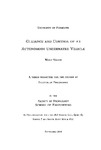Guidance and control of an autonomous underwater vehicle
| dc.contributor.author | Naeem, Wasif | |
| dc.contributor.other | Faculty of Science and Engineering | en_US |
| dc.date.accessioned | 2013-11-22T13:27:57Z | |
| dc.date.available | 2013-11-22T13:27:57Z | |
| dc.date.issued | 2004 | |
| dc.identifier | NOT AVAILABLE | en_US |
| dc.identifier.uri | http://hdl.handle.net/10026.1/2822 | |
| dc.description | Merged with duplicate record 10026.1/856 on 07.03.2017 by CS (TIS) | |
| dc.description.abstract |
A cooperative project between the Universities of Plymouth and Cranfield was aimed at designing and developing an autonomous underwater vehicle named Hammerhead. The work presented herein is to formulate an advance guidance and control system and to implement it in the Hammerhead. This involves the description of Hammerhead hardware from a control system perspective. In addition to the control system, an intelligent navigation scheme and a state of the art vision system is also developed. However, the development of these submodules is out of the scope of this thesis. To model an underwater vehicle, the traditional way is to acquire painstaking mathematical models based on laws of physics and then simplify and linearise the models to some operating point. One of the principal novelties of this research is the use of system identification techniques on actual vehicle data obtained from full scale in water experiments. Two new guidance mechanisms have also been formulated for cruising type vehicles. The first is a modification of the proportional navigation guidance for missiles whilst the other is a hybrid law which is a combination of several guidance strategies employed during different phases of the Right. In addition to the modelling process and guidance systems, a number of robust control methodologies have been conceived for Hammerhead. A discrete time linear quadratic Gaussian with loop transfer recovery based autopilot is formulated and integrated with the conventional and more advance guidance laws proposed. A model predictive controller (MPC) has also been devised which is constructed using artificial intelligence techniques such as genetic algorithms (GA) and fuzzy logic. A GA is employed as an online optimization routine whilst fuzzy logic has been exploited as an objective function in an MPC framework. The GA-MPC autopilot has been implemented in Hammerhead in real time and results demonstrate excellent robustness despite the presence of disturbances and ever present modelling uncertainty. To the author's knowledge, this is the first successful application of a GA in real time optimization for controller tuning in the marine sector and thus the thesis makes an extremely novel and useful contribution to control system design in general. The controllers are also integrated with the proposed guidance laws and is also considered to be an invaluable contribution to knowledge. Moreover, the autopilots are used in conjunction with a vision based altitude information sensor and simulation results demonstrate the efficacy of the controllers to cope with uncertain altitude demands. | en_US |
| dc.description.sponsorship | J&S MARINE LTD., QINETIQ, SUBSEA 7 AND SOUTH WEST WATER PLC | en_US |
| dc.language.iso | en | en_US |
| dc.publisher | University of Plymouth | en_US |
| dc.title | Guidance and control of an autonomous underwater vehicle | en_US |
| dc.type | Thesis | |
| plymouth.version | Full version | en_US |
| dc.identifier.doi | http://dx.doi.org/10.24382/4650 |
Files in this item
This item appears in the following Collection(s)
-
01 Research Theses Main Collection
Research Theses Main


